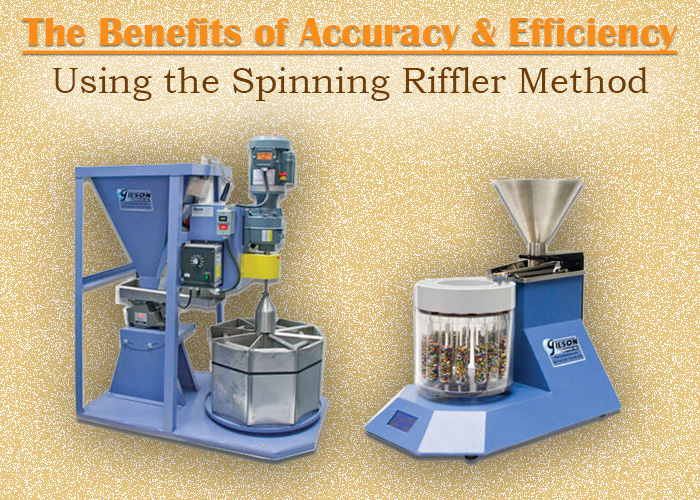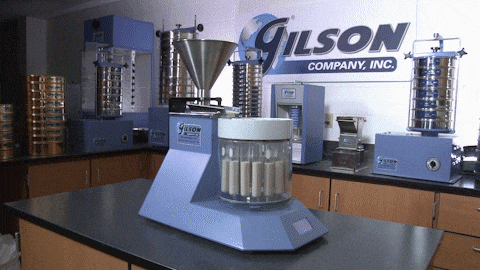
Whether called a Spinning Riffler or Rotary Sample Divider, the premise behind the how and why of this style of widely-used sample divider is the same: it offers a superior and demonstrated capability to produce accurate representative samples efficiently and consistently, with virtually no operator error and little bias. Since any test result is only as good as the specimen used, accurate sampling should be considered as having primary importance in any testing process.
Spreading the Word
Although they’ve been around since the 1930s, an article published in The Chemical Engineer in 1970 brought an enhanced awareness of spinning rifflers – and their ability to deliver optimal reliability and sampling accuracy. The thesis article, Critical Evaluation of Powder Sampling Properties, written by Terrence Allen and A.A. Khan, post-graduate students from the UK’s University of Bradford, statistically validated the higher level of performance of the spinning riffler method over other common sampling techniques.
What was summarized by Allen and Khan nearly 50 years ago still stands true today: “The spinning riffler is the best technique by far and produces good results, no matter what the previous history of the powder (it samples unmixed just as efficiently as mixed powders).” In conclusion, the pair also said about the spinning riffler, “This is the only technique which will invariably furnish samples to the accuracy required by British Standards for Particle Size Determinations of Fine Powders (B.S. 3406, 1963).”
Based on the suppositions studied and substantiated in the Allen and Khan paper, the spinning riffler then demonstrated greater efficiencies and markedly higher accuracy in comparison to scoop sampling, cone and quartering, table sampling, and chute riffling sampling procedures. That high level of efficiency and accuracy still exists today, when looking at the performance of Gilson Spinning Rifflers and comparing the five common sampling procedures.

| Method | Standard Deviation Of Samples (%) | Variation | Estimated Maximum Sample Error (%) |
| Cone & Quartering | 6.81 | 46.4 | 22.7 |
| Scoop Sampling | 5.14 | 26.4 | 17.1 |
| Table Sampling | 2.09 | 4.37 | 7.0 |
| Chute Riffling | 1.01 | 1.02 | 3.4 |
| Spinning Riffling | 0.125 | 0.016 | 0.42 |
| Random Variation | 0.076 | 0.0058 | 0.25 |
The Mechanics of Spinning Rifflers
Theoretically, how spinning rifflers' work hasn’t changed through the years. Bulk samples still continuously stream from a hopper into the vibratory feeder for distribution to the dividing head and into the collection pans/vessels.
Another constant over the past several decades is that the mechanics of spinning rifflers/rotary sample dividers align with what could be considered an industry principle – The Golden Rules of Sampling.
The Golden Rules of Sampling
These two rules are attributed to inventor/scientist John von Neumann, who introduced them in 1947. |
Rotating motion is the basis of spinning rifflers, it’s easy to see how rotary action Sample Splitters and Dividers work across the board in providing efficient, accurate, and equal sampling for many bulk materials, from fine powders to large aggregates:
- Dry, fine granular materials or powders often found in the pharmaceutical, powdered metal, grain, and food industries are reliably and accurately processed. The vibratory feeder provides a constant, even flow of materials for equal and fully representative sample distribution into vessels for analysis.
- Large bulk samples of aggregates, coal, ores, or other minerals with particle topsize up to 2in (50.8mm) are quickly and accurately split to 1/8 or 1/4 fractions, resulting in less handling and sample loss, and yielding the desired quality of equally representative samples.
- Samples that normally would not flow well through fixed-chute gravity splitters are easily and accurately processed through a spinning riffler’s vibratory feeder for quick and optimum results.
We’ve already stated that since Allen and Khan’s thesis in 1970, spinning rifflers continue to consistently provide the highest level of accuracy for applications and sample materials that work best with this type of sample divider. It goes without saying that over the past decades, as with any technological advances seen in automobiles, appliances, electronics, industrial equipment, and so on, spinning rifflers have also evolved through improved and streamlined design, construction, mechanical structure, functionality, and more.
Types of Spinning Rifflers
Spinning Rifflers are available in table-top or free-standing models and come with a variety of standard components and optional accessories. Total hopper capacity varies by model and type, as an opening size of the discharge sliding gate, rotation speed, number of collection pans/vessels, and other features. Gilson offers two spinning rifflers (rotary sample divider) models.
The Gilson Spinning Riffler has a 1L (61in³) hopper volume and capacity for up to 16 primary samples and is optimized for the processing of powders and finer granular materials.
The Gilson Bulk Spinning Riffler, with a 1.8ft³ (51L) hopper capacity, is designed for larger samples of materials with wider gradations ranging up to 2in (51mm) particle sizes.
Optional accessories can include test tubes, sample vials, and other sample collection vessels; additional sample drum, vessel holder plate, and dividing head; collection pans to accommodate different fraction sizes and so on.
Advantages of Spin Riffling
- Highest level of accuracy in the production of representative samples
- Significantly less variance of results compared to other sampling and dividing methods
- Able to produce a higher number of samples in a single operation
- Dividing heads rotate and distribute and produce an equal flow to collection vessels
- The spin riffling method provides time- and cost-effective sample division
- Variable rotation speeds and vibration frequencies are precisely controlled by the user
- Quieter operation
- Works with different bulk materials, not just fine powders
- Meets ASTM Standards ASTM D2013 and ASTM B215
In conclusion, it’s important to keep in mind that sampling and dividing is not a cookie-cutter operation and that even with the benefits of spin riffling discussed here, this type of splitter may not always be the ideal choice. Some factors to consider in determining which splitter works best when including:
- Size of bulk samples – samples in quantities exceeding hopper capacities will need to go through preliminary steps to reduce volume.
- Composition of a sample – spin riffling works best with materials that are free-flowing.
- Bulk samples with moisture variations or which produce significant amounts of airborne dust may work best with an enclosed splitter.
For additional information on spinning rifflers or other sampling and dividing units, check out our Material Sampling and Dividing Equipment page, or contact a member of our technical support team today!
















